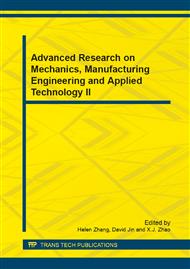[1]
S.P. Kolet, S. Haldar and H.V. Thulasiram, in: Steroids, Vol. 78 (2013), pp.1152-1158.
Google Scholar
[2]
V.V. Kollerov, A.A. Shutov, V.V. Fokina, G.V. Sukhodolskaya and M.V. Donova, in: J. Ind. Microbiol. Biotechnol, Vol. 148 (2006), pp.719-723.
Google Scholar
[3]
C. Perez, A. Falero, and B.R. Hung, in: J. Mol. Catal. B Enzym, Vol. 55 (2008), pp.61-68.
Google Scholar
[4]
S. Ahmad, S.K. Garg and B.N. Johri, in: Biotechnol. Adv, Vol. 10 (1992), pp.1-67.
Google Scholar
[5]
A. Malaviya and J. Gomes, in: Bioresource Technol, Vol. 99 (2008), pp.6725-6737.
Google Scholar
[6]
H.L. Holland, in: Steroids Vol. 64 (1999), pp.178-186.
Google Scholar
[7]
S. Hu, G. Genain and R. Azerad, in: Steroids, Vol. 60 (1995), pp.337-352.
Google Scholar
[8]
S.B. Mahato and S. Garai, in: Steroids, Vol. 62 (1997), pp.332-345.
Google Scholar
[9]
B. Mahato and I. Mazumder, in: Phytochemistry, Vol. 34 (1989), pp.883-898.
Google Scholar
[10]
T. Janeczko, A. Świzdor, J. Dmochowska-Gładysz, A. Białońska, Z. Ciunik and E. Kostrzewa-Susłow, in: J Mol Catal B: Enzym, Vol. 82 (2012), pp.24-31.
DOI: 10.1016/j.molcatb.2012.05.009
Google Scholar
[11]
M.A. Faramarzi, M. Tabatabaei Yazdi, H. Jahandar, M. Amini and H.R. Monsef-Esfahani, in: J Chem Technol Biotechnol, Vol. 84 (2009), pp.1021-1025.
Google Scholar
[12]
M.I. Choudhary, S. Sultan, A. Yasin and S. Farzana, in: Nat Prod Res, Vol. 18 (2004), pp.529-535.
Google Scholar
[13]
A. Romano, D. Romano, E. Ragg, F. Costantino, R. Lenna, R. Gandolfi and F.S. Molinari, in: Steroids, Vol. 71 (2006), pp.429-434.
DOI: 10.1016/j.steroids.2006.01.014
Google Scholar
[14]
Y.J. Shen, H. Sun, Y.W. Fu and M. Wang, in: Adv. Mater. Res, Vol. 343 (2012), pp.70-73.
Google Scholar
[15]
L.H. Huang, J. Li, G. Xu and H.M. Liu, in: Steroids, Vol. 75 (2010), pp.1039-1046.
Google Scholar
[16]
Z.G. Xiong, Q. Wei, H.M. Chen, W. J. Xu and X.M. Hu, in: Steroids, Vol. 71 (2006), pp.979-983.
Google Scholar
[17]
M. Koshimura, A. Hara and M. Kuniyoshi, in: J Mol Catal B: Enzym, Vol. 67 (2010), pp.72-77.
Google Scholar
[18]
V.V. Kollerov, A.A. Shutov, V.V. Fokina, S.A. Gulevskaya and M.V. Donova, in: Appl. Biochem. Micro, Vol. 46 (2010), pp.198-205.
DOI: 10.1134/s0003683810020122
Google Scholar
[19]
Y.L. Lin, X. Song J. Fu, J.Q. Lin and Y.B. Qu, in: J. Chem. Technol. Biotechnol., Vol. 84 (2009), pp.789-793.
Google Scholar


